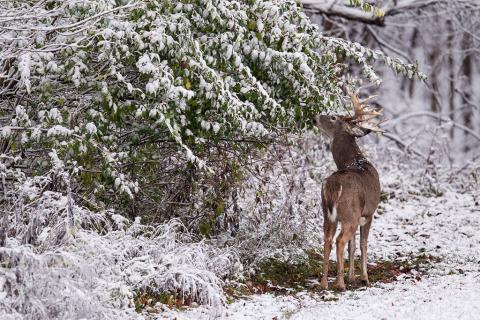Ron Jolly | Originally published in GameKeepers: Farming for Wildlife Magazine. To subscribe, click here.
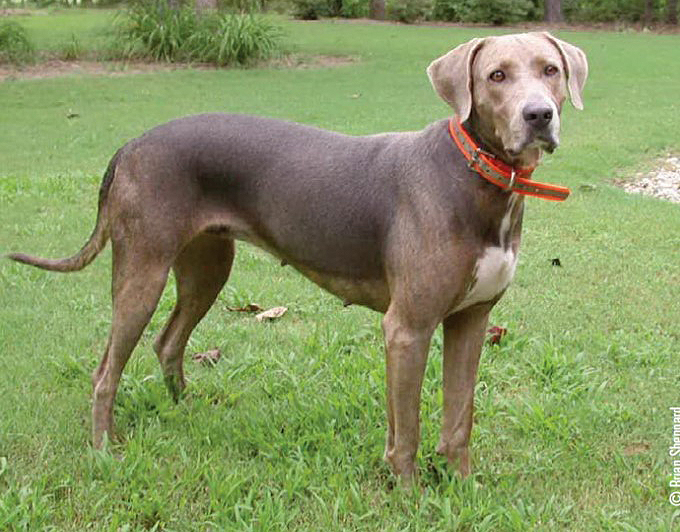
For a gamekeeper, there is no greater reward than knowing your land is home to a trophy and your investment of time, money and hard work has transformed your land into habitat that attracts and holds a mature buck. Trigger-finger decisions made on what to shoot and when have allowed that buck to mature. For my wife Tes and me, there was a two-year waiting period before we began to realize the dream of transforming our small, east-central Alabama farm into what it is today.
That waiting period was a “trying time. By the end of the second year we were discouraged and questioning whether we could expect mature bucks on our relatively small acreage property. Then in September 2009 a single photo of a buck we named “Stickers” pumped some much needed enthusiasm into our effort. We stayed the course and later added other bucks.
In 2010 I was obsessed with a buck we had named LittleJoe the year before. As a three-year-old in 2009 he was impressive, but we passed him several times nonetheless. On the morning of November 18, 2010, I spotted three bucks making their way down the trail towards my stand. I did not need my Nikons to know the third buck was Little Joe.
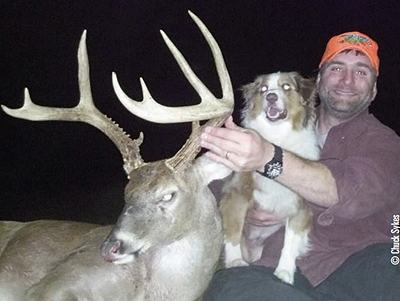
deer, many of which he would have never found without
their help. He puts one or both of the dogs on every deer
he shoots.
The bucks were 80 yards out and approaching at the pace of full-bellied bucks headed to bed. I took my bow off the hook, positioned my feet on the platform, closed my eyes and mentally readied myself for the shot.
When the first buck, a three-year-old eight-point, entered my shooting lane he was 26 yards away. I couldn’t help but think how not long ago I would have proudly shot this buck, but the real prize was still 45 yards out. Little Joe would be the highest scoring buck ever shot on this farm. I guessed he would gross near 150 inches as a nine point.
The second buck, another three-year-old eight point, passed through my lane without detecting me. Now my focus was on Little Joe. As he entered the lane, my bow came to full draw effortlessly. A soft grunt stopped him in the center of the shooting lane. One last deep breath as the release touched the familiar spot at the corner of my mouth. I focused on the crease behind his right shoulder and centered my 20-yard pin two inches high of dead center.
In the blink of an eye my arrow had passed through the buck and stuck in the ground. He was now standing 80 yards away not knowing what had happened. I did! Instead of hitting heart and lungs, my arrow had hit a full eight inches left. Liver hit at best…guts for sure.
I grabbed my binoculars hoping they would dispel the image burned into my brain. They did not. With a twitch of his tail Little Joe turned and disappeared into the timber. I sat down and tried to control the shaking.
Two torturous hours later I climbed down and went to the arrow. The green coating on the shaft reinforced what I already knew. Six hours later I took up the trail. A hundred yards later I saw him get up and run away. I backed out and hoping he would not go far and I could find him the next day.
That was one of the worst nights of my life. I simply couldn’t understand what had gone wrong. At first light, a friend and I started where the buck had jumped. There was a small amount of blood in the bed but nothing to follow from that point. After an entire day of searching we called it off. The next day I got the call at work. Tes had found what was left of Little Joe - the coyotes had had their way with the rest.
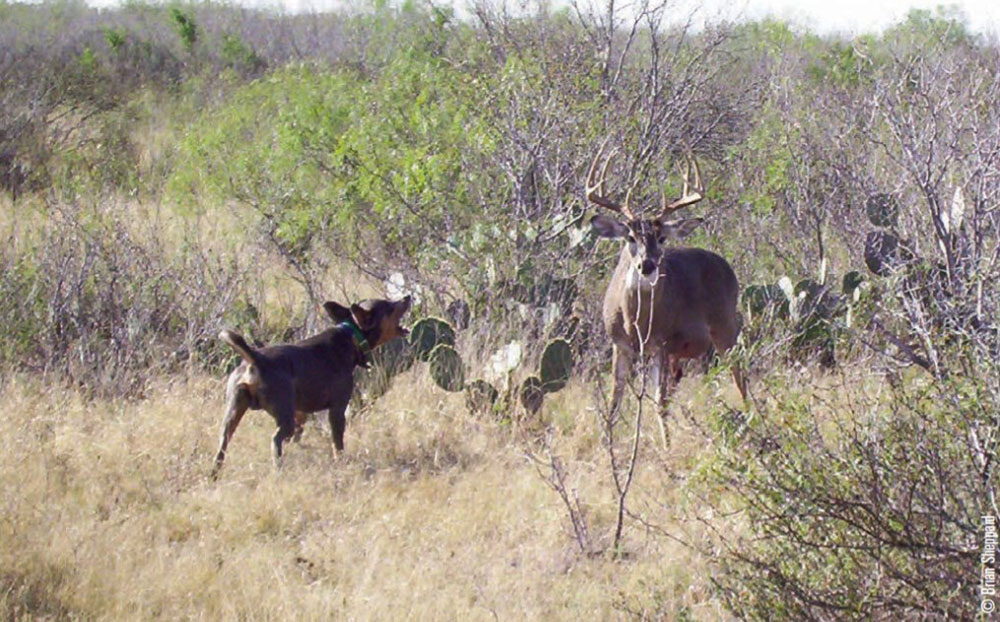
It Happens!
We have all heard the phrase “That’s hunting, it happens,” and sadly it does. Responsible hunters do everything possible to avoid it. The question is, “what do you do when you make a bad shot?” With Little Joe, I did what years of experience had taught me. Get away, give it time and do not push the buck. Eight torturous hours proved not enough time to wait on recovering this beautiful buck. So how do you know what is enough time before taking up the trail?
In the end, we were able to recover what was left of Little Joe. That was small consolation. The guilt I felt for not making a good shot and then losing the blood trail caused me to take a hard look at myself and do everything I could to not let it happen again.
At the time I did not know anyone who had a blood-trailing dog. Since then, I have made a serious effort to learn about dogs used to find wounded deer and who to call should we even need help recovering one.
Chuck Sykes
Chuck Sykes is Director of Alabama’s Department of Wildlife and Freshwater Fisheries and host of the Management Advantage television series. Sykes also owns dogs that are trained to recover wounded deer.
“My dogs are miniature Australian Shepherds. They are companion dogs and pets. When I use my dogs to trail deer I am very careful not to get them hurt, so I don’t put them on a big buck that I fear may still be alive,” said Sykes. “My dogs are show dogs that didn’t make the cut, but they are like my kids. I spend all my free time with these dogs.”
“When my female was around three months old I took her with me to track a doe I had shot with my bow. I was on my hands and knees moving from one spot of blood to the next. She was bouncing around, playing - just being a pup. Then I noticed her several yards ahead of me with her nose on the ground. I went to her and there was blood on the ground. She moved several yards further and began smelling the ground. I went to her and found more blood. When she found the deer it scared her to death but with some encouragement she began smelling and biting the doe,” said Sykes
“Since that day she has found lots of deer, many of which I would have never found. I put one or both of my dogs on every deer I shoot. Repetition increases a dog’s ability to work out hard trails. You have to learn to trust your dog,” said Sykes. “Good blood trail dogs are able to distinguish if a deer is mortally wounded. They act and work the trail differently if the deer is mortally wounded. They can also distinguish the wounded deer from other deer in the area.”
“I am not recommending miniature Australian Shepherd’s as a top breed for blood trailing dogs. I just know that my two trail, and find deer,” said Sykes. “There are other breeds more suited to the rigors of recovering wounded deer.
Meet Otis
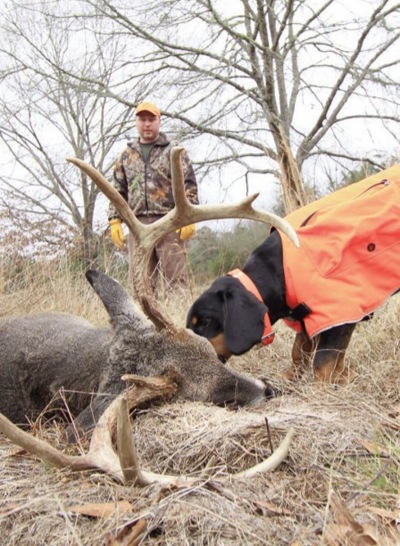
of hunting. He also enjoys helping other people find their
deer.
Otis is an eight-month-old Slovensky Kopov. His owner is my neighbor and friend, Harold Kowalsky. Harold purchased Otis with the full intent of training him as a blood trail dog. “I have lost several deer over the years and decided my next dog would one bred for this job. I wanted a smaller dog that was noted for its intelligence and disposition.
Popov’s fit that mold. I wanted a tough breed that would also be a good family pet since I have twin five-year-old boys and the dog had to be a part of our family;” said Kowalsky.
“I purchased Otis when he was two months old. I immediately began a bonding program with him. I wanted him to have manners and know basic commands. I began with sit, stay, pay attention to me and kennel. I reinforced these commands with treat rewards,” said Kowalsky. “Once he began obeying, I started laying down short blood trail lines using beef liver for the scent on the ground and the reward at the end of the line.”
“Otis improved with each line he ran. I began making the lines longer and putting checks, or ninety degree turns in the line. I changed from beef liver drags to deer hide sprayed with deer blood and kept the liver as a reward for successful runs,” said Kowalsky.
“When Otis was six months old I put him on his first real deer,” said Kowalsky. “This was a staged event where I knew the deer was dead and where it was. Otis followed the blood straight to the deer. I have done this several times since and so far I could not be more pleased.”
Kowalsky has contacted every hunting club, lodge and friend he could find to offer Otis’ services. The idea is to put him on as many trails as possible in his first season. “I believe repetition is a key to developing a good blood-trailing dog,” said Kowalsky. “I have always enjoyed the tracking part of hunting. I also enjoy helping other people find their deer. I plan to do all I can to make Otis the best he can be. I do not want him to get hurt or have a bad experience, so I will try to choose tracks that have a dead deer at the end of them to begin. With age and experience I believe due to his breeding he will be tough enough to hold his own and bay a wounded deer.”
The Professionals
Bobby Culbertson—Tara Wildlife
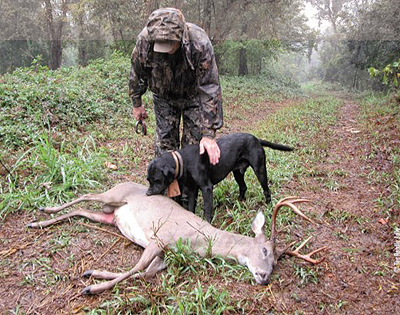
that ran out of sight. Forty-three of those bucks were
recovered. The dogs are invaluable when blood trailing
deer in wet conditions.
Bobby Culbertson is head guide at Tara Wildlife in Mississippi. Tara is a first-class, "bow only" operation that harvests over three hundred deer each season. Blood dogs play a huge role in the hunter success that has made Tara a premiere bowhunting destination.
“We use Labrador Retrievers, mostly male dogs,” said Culbertson. “Our dogs are the big Labs and very few females have the stamina and drive to cut it here. We try to have at least one six-to-eight-month-old pup to start each season. Our hunters have specific instructions to not trail a wounded deer. If a deer dies in sight of a hunter he can go look at his deer, but he is not to move that deer. If we have a young dog we allow him to find the dead deer. It’s all about repetition!”
“These dogs are like family. They go with us everywhere we go. They work hard and by the end of the season they are pretty lean. Their chest and face are bald from the briars. These dogs often recover six, seven, eight deer a night! When a young dog is proficient at finding deer we know are dead, we start letting him run with an old dog on a more difficult track. It doesn’t take long for that pup to catch on. Normally after one season the pup has developed into a legitimate blood trailer,” said Culbertson.
“These dogs are like pets most of the day. We attach cowbells to their collars before turning them out on a track. The sight and sound of the bell flips a switch in these dogs. They are all business from that point on. We also use tracking collars in case we lose contact with the bell.”
“We put one tracking dog on the trail and hold another dog on leash. This dog is the catch dog. He is usually a big male that has a lot of grit. If the tracking dog jumps or bays a wounded deer we turn the catch dog loose. We can usually tell early on if we have a mortally wounded deer,” said Culbertson. “The dog just acts differently. He has his nose on the ground and is all business. I believe mortally wounded deer give off a unique scent and the dog recognizes this scent.”
“We owe it to our customers to do everything we can to recover their deer. These dogs give us a tremendous advantage in this task. Many times the dogs will bay a wounded deer and we rush in and dispatch the animal as humanely as possible. We owe it to the deer and the dogs. A cornered buck weighing well over 200 pounds is a powerful animal. He can hurt a dog if we don’t get there fast and put him down.”
I asked Culbertson to explain to me just how valuable these dogs are to Tara’s success. He summed it up by saying—“So far this season we have shot 76 bucks at Tara. 28 of those died in sight of the hunter. We put the Astring dogs on the 48 bucks that ran out of sight. We took 43 of those bucks to the skinning shed. These dogs can do more on a track in five minutes than we can with a light in an hour. I’d have to say these dogs are invaluable!”
“It’s a love/hate relationship with these dogs the first two years,” says Culbertson. “They are learning and don’t have the experience needed to be consistent. From three to five years old they are great! At age 5 through 8 they are bullet proof! They have seen and done it all. At age nine they begin to slow down and loose some of their go power. At 10 years old they have earned their place on the porch and by the fireplace where they spend the rest of their days living the good life!”
Brian Sheppard
Brian Sheppard is a for-hire tracker who lives in Pine Mountain, GA. He covers Alabama and Georgia and uses dogs bred by the Hindes family from Texas to trail wounded deer.
“My dogs go back to the line of dogs bred by the infamous Hindes family in Texas,” said Sheppard. “They are a mix of Blue Lace, Black Mouth Cur and Catahoula Leopard Cur. They have tremendous grit and are very good at finding wounded deer. They have found literally hundreds of deer that hunters could not.”
“I start my dogs by first making them my friend. I keep them with me as much as possible and let them know when they do things that please me. When you do that, they instinctively learn what is expected of them. Short, easy blood trails created with a deer leg sprayed with deer blood is how I start them. They begin at six months old and I make the trails progressively more complicated. These dogs are bred to trail blood so it only takes a short while and some positive reinforcement for them to understand it’s their job.”
“When a hunter calls me to help find a wounded deer I ask specific questions,” said Sheppard. “Was the shot with a gun or a bow? Where did you hit the deer? How long has it been since the shot? Have you tried tracking the deer and did you jump it? The hunter’s answers to these important questions determine how I approach recovering the animal. I like to wait three hours before turning my dog out on a gunshot deer and four or more hours on a bow-shot deer. Shot placement plays a huge part as does an undisturbed trail.”

chance of recovering your deer. Here is Bill Keith with a
nice buck recovered by Brian Sheppard and his dog.
“These dogs know if a deer is mortally wounded. There are times when I know by how the dog is working if the deer we are trailing is not dead or catchable,” said Sheppard. “I believe mortally wounded deer give off a different scent. I use a Garmin tracking collar on my dog and use Birdseye software to know where my dog is and what kind of terrain we are dealing with. These dogs can travel great distances on a track. If a deer is dead or badly wounded, odds are they will find or bay that deer.”
“As a hunter you owe it to any deer you shoot to make every effort to recover it. Sadly, calling in a blood dog is often the last resort. It should be the first thing you do if you suspect your shot was marginal. A good dog on an untainted trail greatly increases your chance of recovering your deer. Whether the dog finds your deer or not, you know you have done everything possible to recover the animal.”
Closing Thoughts
When I shot Little Joe in 2010, I did not know anyone in our area who owned a blood dog. If I had you can believe I would have called them to help. I also believe we would have found him before the coyotes.
To this day, that experience remains the all-time low for me as a bowhunter. It was an experience that can happen to anyone, but it happened to me! I took it personal and never want to go through that again. I now have several blood dog owners on speed dial on my phone. I will not hesitate to make the call next time.
If you are looking for a high quality archery hunt in the south you cannot go wrong at Tara Wildlife. They can be reached at 601-279-6506. If you live in Alabama or Georgia and need the services of a professional blood dog handler Brian Shepard can be reached at 706-718-1690. Harold Kowalsky will have a dependable blood dog ready for service in the Macon County, Alabama area in 2015. He can be reached at 334-421-1811.
These are the guys I met and interviewed for this article. I am certain with a little effort you too can locate a blood dog in your area that could salvage your hunt of a lifetime!















